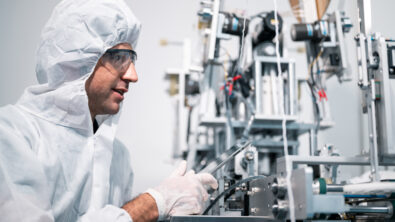CES 2024: Innovations in the medical device industry

CES 2024 is just weeks away and we’re counting down the days till we can share and discover the latest innovations and advancements in tech across industries. This year’s theme is Human Security for All, which emphasizes the critical role technology plays in making the world safer and more sustainable for everyone, encompassing topics from environmental protection to healthcare access and food security. With keynote conversations featuring leaders in technology, consumer goods and healthcare spaces, CES 2024 invites us to consider how we can come together to engineer solutions that solve global human security issues.
In the opening keynote, Siemens AG CEO Dr. Roland Busch will kick off these conversations by revealing how combining the real and digital worlds empowers manufacturers everywhere to transform the everyday, for everyone. Throughout the four-day event, we’ll dive into the various ways that Siemens technology is helping our customers make the world more accessible for all, with one of the key areas being the medical device industry. Read on for a sneak peak of what awaits at CES and discover more ways that Siemens digital solutions are reshaping the medical device and healthcare industries.
Unlimited Tomorrow: Breaking barriers in access to prosthetics
Our booth at CES will highlight multiple customer success stories from across industries. One story we’re excited to share comes from Unlimited Tomorrow, a manufacturer of personalized, affordable prosthetic arms.
The traditional process of creating prosthetic limbs is costly and can take up to a year. For users who are children and may still be growing, this process can leave them with a prosthetic that no longer fits at the time of delivery. Using Siemens NX software, Unlimited Tomorrow is able to drastically shorten the time it takes to create a prosthetic. Unlimited Tomorrow makes it easy for users to order a prosthetic from the comfort of their home using a scan app on a mobile device. Once the scans are received, Unlimited Tomorrow designs a man/machine “socket” to fit the prosthetic to the patient’s partial arm, 3D prints the prosthetic and ships it to the customer. They typically receive their lightweight prosthetic arm five times faster than the traditional process.

How additive manufacturing is reshaping the medical device industry
Unlimited Tomorrow isn’t the only example of how additive manufacturing can be used to transform the medical device industry and elevate patient care with high-quality, durable products. Additive manufacturing makes it possible to easily develop custom prosthetics, implants and orthopedic surgical guides that are as unique as the patients they serve.
Similar to the process of producing prosthetics, custom orthopedic surgical guides can also be created from patient scans and developed individually. Surgical cutting guides are used to limit cuts to a specific area, allowing surgeons to make precise cuts when removing a diseased or injured area of a bone before inserting a replacement. Traditionally, surgeons would use patient scans to determine the position and location of the cuts, then estimate what size of cutting guide is necessary. During the operation, they would then make the final decision about the size and position of the guide, selecting from a collection of generic sizes.
With additive manufacturing and modern design software, surgeons can use the same patient scan data to mold the cutting guide to the shape of the patient’s bone and virtually place it in the exact position necessary to make the most precise cut. The end result? Less invasive surgeries and faster recovery times for patients.
Additive manufacturing is also broadening the types of implant materials available. Traditional implants used in procedures such as knee replacements are bonded to the bone using a cement adhesive. This adhesive will gradually weaken over time, often leading to an implant replacement later down the line. Several companies are now using metal-based lattice structures to promote bone growth into knee, hip and shoulder replacements. Lattice structures are three-dimensional arrangements of a material at a small scale. They form a scaffold-type structure that is lightweight yet strong. Medical companies including LimaCorporate have designed lattice structures that can integrate directly with new bone growth when used as implants. Unlike cement, this bond actually grows stronger over time, leading to long-term durability.

Enhancing digital health security
Medical devices are becoming a daily part of our lives, whether it’s a patient using a device that connects to their cell phone to help manage a chronic condition, or healthcare professionals managing healthcare workflows. These devices make our lives easier and more connected, but they collect sensitive information that must be handled carefully. In order to protect patient safety and confidentiality, it’s imperative that medical devices are secured against bugs and cybersecurity vulnerabilities.
Siemens Connected Care solutions equip medical device manufacturers with tools to improve the safety, quality and performance of their products. With our low-code application development platform, Mendix, and a robust cybersecurity framework, manufacturers can work collaboratively to build devices that enhance user experience and create apps for all forms of interaction – handheld to augmented reality. For the best user experience, our solutions improve device functionality and future-proof the software to ensure smooth upgrades.
Visit Siemens at CES
Are you attending CES 2024? Don’t miss Dr. Roland Busch presenting his keynote, “Redefining reality: How AI and the industrial metaverse will transform the everyday” on January 8 at 6:30 PM PST.
Stop by our booth from January 9-12 to chat with us and discover how organizations around the world are using our technology to transform the everyday. Find us at booth 10044 in LCVV, North Hall. If you can’t join us in person, be sure to catch the live stream. We can’t wait to see you there!


